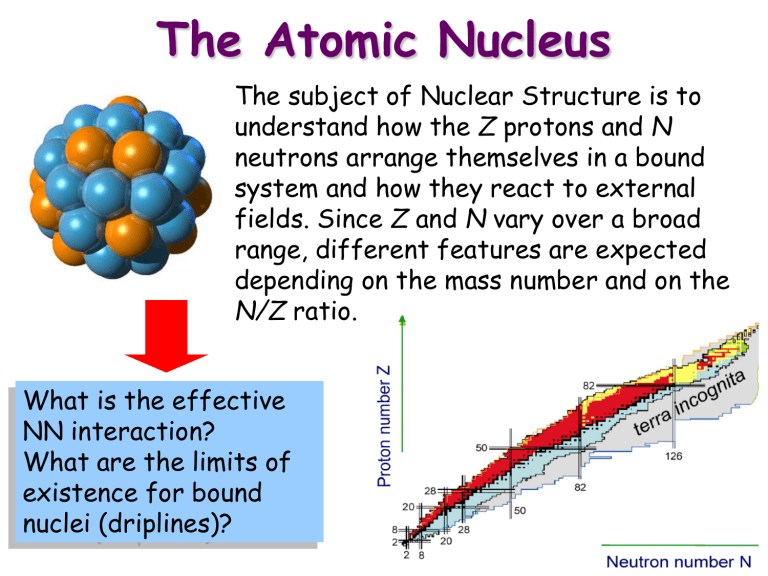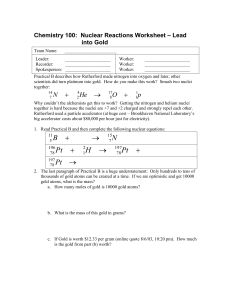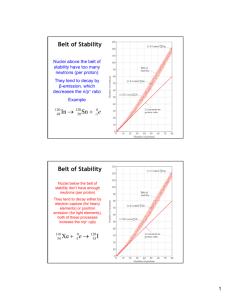E - GRUPPO III - Experimental Nuclear Physics Group

The Atomic Nucleus
The subject of Nuclear Structure is to understand how the Z protons and N neutrons arrange themselves in a bound system and how they react to external fields. Since Z and N vary over a broad range, different features are expected depending on the mass number and on the
N/Z ratio.
What is the effective
NN interaction?
What are the limits of existence for bound nuclei (driplines)?
The Shell Model
There is a “surprising” analogy between the description of bound electrons in atoms and bound nucleons in atomic nuclei.
Nuclear Shell Model
(M.Mayer et al, 1948-49)
This model is a highly successful one, but the prediction capabilities are somewhat limited when going to nuclei far from stability
Need to “tune” the model parameters collecting information on such nuclei!
Nuclear excitations
Shell structure
Cooper pairing
Collective modes
Nuclear Physics and Stellar Nucleosynthesis
• What is the origin of elements heavier than Iron?
• How do stars burn and explode?
• What is the structure of a neutron star?
X-ray burst
4U1728-34
331
330
329
328
327
10 15 20
Time (s)
Nova
Neutron star
T Pyxidis protons neutrons
Nuclei and Stars
Stable nuclei proton drip-line neutron drip-line heavy-ion collisions
10 ρ
0 supernovae
Symmetry Energy: Nuclei and Stars
The symmetry energy determines the dynamics of supernovae explosions and the pressure in neutron stars:
P sym
(ρ,δ) = ρ 2 (∂E sym
/ ∂ ρ ) δ 2 = ρ
0
E sym
(ρ o
)
u
+1 δ 2
E sym
(ρ) = E sym
(ρ o
) u
u= ρ/ρ o
Observables (input to the models):
Dynamics of heavy-ion collisions at different N/Z ratios
Structure of nuclei far from stability: single-particle and collective properties
How can we perform nuclear structure studies?
• In order to study the structure of nuclei, we need to find them in an excited state and to observe the radiation (light particles, electrons, -rays) which they do emit during the de-excitation.
• Excited nuclei can be populated “naturally” by decay of long-lived radioactive nuclei, or by reactions induced by cosmic rays
• Excited nuclei can be populated “artificially” by inducing nuclear reactions in our laboratories, using accelerators
TANDEM PIAVE ALPI COMPLEX
SC Booster ALPI
68 SC Quarter Wave Resonators (Nb, Nb/Cu)
V eq
~ 48 MV, species from 28 Si to 197 Au
Injected by Tandem or PIAVE
V
T
~ 14,5 MV
From H to 197 Au, E = 30 ÷ 1.5 MeV/A
CW or pulsed
XTU-Tandem
PI Injector PIAVE
ECR on 350 kV platform
SC-RFQs and QWRs
V eq
~ 8 MV
Fully operational with noble
Gases; ECRIS replacement in Spring 2008
Producing nuclei far from stability
Using stable beams at energies close to the Coulomb barrier, with a careful choice of the reaction mechanism it is possible to populate nuclei far from stability in different regions of the chart of nuclides
Observing nuclei far from stability
• Following the production of excited, exotic nuclei, there are two basic alternatives, implying quite different experimental problems:
– Transport the excited nuclei elsewhere and observe the
(delayed) decays (or chains of decays) off-line
– Observe the prompt decays on-line, as they are produced
Gamma Spectroscopy
• The observation of the electromagnetic radiation
(photons or -rays) emitted by the excited nuclei provides one of the most sensitive tools to investigate the nuclear structure
• The emission of -rays is a well understood process from the theoretical point of view, hence the smallest effects can provide valuable information on the nuclear structure
• Contrary to the detection of particles, high resolution is possible
Detectors
• A detector is an object translating the arrival of a radiation quantum into a (measurable) electric signal which can be:
– generated outside of the active volume of the detector (eg scintillators coupled to photomultiplier tubes)
– generated inside of the active volume of the detector (eg semiconductor detectors)
Current mode
A possible mode of operation consists in measuring the average current produced within the detector.
I
This mode of operation is not much used in spectroscopy since there is no information on the energy of the individual radiation quanta, only on their rate.
Pulse mode
Here the information on energy and time of arrival of the individual quanta is preserved.
Typically, the charge flowing at the detector electrodes is collected by a preamplifier , which we can approximate by a RC circuit.
RC small compared to the charge collection time: the output signal is basically the same as the current signal:
V(t)=R i(t)
RC large compared to the charge collection time: the output signal rises as the current signal and decays exponentially with time constant RC. Its amplitude V=Q/C is proportional to the energy if C is constant.
Spectra
The usual way to visualize the response of a detector is a differential spectrum, namely a histogram in which each channel content is the number of events with amplitude within the “bin”.
The integral version is not as widely used.
Differential Integral
Resolution
When monochromatic radiation hits a detector, one expects that the response of the detector is always the same, in other words, that a peak appears in the differential spectrum.
The resolution
R is defined as the ratio between the peak full width at half maximum (
FWHM
) and its position,
R=FWHM/H
0
, but conventionally the values of
FWHM and energy can be provided. For gaussian peaks, the statistical limit is:
2 .
35
R
N where
N is the peak area. In practice the resolution can be better than such a limit and the
Fano factor
F<1 is introduced:
R
2 .
35
F
N
Efficiency
• The absolute efficiency is defined as the ratio between the number of detected and emitted quanta
• The intrinsic efficiency is defined as the ratio between the number of detected quanta and the number of quanta hitting the detector
• These two quantities are related by geometrical factors
• The peak efficiencies (absolute and intrinsic) are defined in a similar way
Interaction of radiation with matter
• As a rule of thumb:
– Charged particles (electrons, protons) release their energy in a gradual and continuous way
– Neutral particles (neutrons, photons) release their energy through “catastrophic events” changing their energy and/or nature in a radical way
Photon Interaction Mechanisms
~ 100 keV ~1 MeV ~ 10 MeV -ray energy
Photoelectric
Production
Compton Scattering Pair
E
γ'
1
E
γ m
0 c
2
E
γ
1
cosθ
Photoelectric Absorption
A photon can interact with an atom, releasing an electron with energy:
E e
=E
-E b where
E b is the electron binding energy. The ionised atom can then rearrange its electrons, emitting X-rays which are typically reabsorbed. In first approximation, the cross section for photoelectric absorption is:
z n
E
3 .
5
, n
4
5
Shell effects, however, are typically quite evident.
Compton Scattering
Compton scattering is the elastic scattering of a photon on an electron. For a free electron, the energy of the scattered photon depends on the scattering angle :
E
1
E
E
1
cos
m e c
2
The energy of the scattered electron in the extreme cases, 0 , is:
E e
0
0
From which we obtain the gap between the photon energy and the maximum electron energy (which for large values of
E
is approximately 256 keV):
E e
E
2 E
1
2 E
m e c
2 m e c 2
E
C
E
E e
E
1
2 E
m e c
2
Compton Scattering
The angular distribution of the scattered photon is described by the Klein-
Nishina formula: d
d
z r e
2
1
1
1
cos
2
1 cos
2
2
1
1
cos
2
2
1
1
cos
1
2 cos
where
=E
/m e c 2 and r e is the classical electron radius.
For photon energies larger than a few hundred keVs the angular distribution is highly anisotropical and peaked to small forward angles. It strongly decreases with the increasing photon energy.
Continuum Compton
The spectrum of the scattered electrons can be deduced from the Klein-
Nishina formula: d N d E e
1 f
2
2
e
1
1
f
1
2
e
E
E e
2
E
E e
where: f
e
1
m e c
2
E
E
E e
E e
Compton shoulder
1332 keV photons
Since the actual energy deposition is performed by the electrons, photons interacting via Compton scattering will produce a continuum spectrum as shown here. Corrections are needed since electrons are not free, rather bound in materials, producing a smoothening of the actual spectrum
( Compton profile )
Pair production
Photons with energy larger than
2m e c 2 can materialize (in the Coulomb field of a nucleus) in an electron-positron pair with total kinetic energy
E
-2m e c 2
.
Electron and positron subsequently release their energy in the medium; the positron eventually annihilates releasing two 511 keV photons.
1. The threshold for this process is 1.022 MeV
2. This process dominates at high photon energies (
E
> 10 MeV
)
3. This process depends approximately on the square of the atomic number of the medium.
Cross Sections in NaI(Tl)
NaI(Tl)
Atomic shell K
Photoelectric abs.
Energy (MeV)
Pair prod.
Compton scatt.
Cross Sections in Germanium
Photoelectric
Compton scatt.
Pair prod.
Mean free path : l
( E ) = M
A
/(N
AV
.
r
) . 1/
S
E l
(10 keV) ~ 55 m m l
(100 keV) ~ 0.3 cm l
(200 keV) ~ 1.1 cm l
(500 keV) ~ 2.3 cm l
(1 MeV) ~ 3.3 cm
Response function
• The response function is the differential spectrum obtained with a detector when hit by monochromatic radiation
• We can consider some schematic cases:
– Large detectors
– Small detectors
– Intermediate size detectors
“Large” detectors
In the ideal case of a very large detector
(with respect to the mean free path of the radiation), the incoming radiation is fully absorbed.
Since it is not possible to discriminate the time at which the individual interaction points are produced, the detector is only sensitive to the total energy deposition.
“Large” detectors
Ideal Ge sphere, 1 m diametre.
3 MeV photons
Full-energy peak
The response function of a
“large” detector is very simple and it includes only a fullenergy peak (which in most practical cases can be treated as a photopeak).
Lucrecia TAS at GSI
Some devices ( Total
Absorption
Spectrometers ) are a good implementation of this limit!
“Small” detectors
E=1.33MeV
Compton continuum
E=3MeV
Double escape peak full-energy peak
In this case there is a high probability that the incoming photons are only partially absorbed.
In the response function, besides the full-energy peak , one can identify a continuum generated by photons which underwent Compton scattering and, if the photon energy is larger than 1.022 MeV, peaks due to the missed detection of one or both the annihilation photons ( single and double escape peaks ).
Intermediate size detectors
The situation is qualitatively similar to the case of “small” detectors, although in practice also other components can be identified, due for instance to the environmental background (eg 40 K), to the bremsstrahlung radiation, to the X-rays characteristic of the material surrounding the detector and a peak of approximately 250 keV due to the back scattering of the incoming photons.
Full-energy peak
Compton continuum
Single-escape peak
Double-escape peak
HPGe detector used with the
GASP array
In-beam
-ray spectroscopy
What we want … What we get …
152 Dy
Our goal is to extract new valuable information on the nuclear structure through the -rays emitted following nuclear reactions
Problems: complex spectra!
Many lines lie close in energy and the
“interesting” channels are typically the weak ones ...
The nucleus is always full of surprises
Instrumentation advances New Science
New tools for new phenomena
With high-resolution devices the nuclear world seems quite different!
From Sodium Iodide to
Germanium detectors
Continuous effort to consistently improve our detectors and their response function
104 Ag and 106 Ag
Spectroscopic history of
156
Dy
156 Dy The “spectroscopic history” of 156 Dy is a notable example of how the progress with the acceleration and detection techniques leads to better insight on the nuclear structure.
Challenges in
Nuclear Structure
Shell structure in nuclei
• Structure of doubly magic nuclei
Transfermium nuclei
Proton drip line and N=Z nuclei
• Spectroscopy beyond the drip line
• Proton-neutron pairing
• Isospin symmetry
48 Ni
100 Sn
Nuclear shapes
• Exotic shapes and isomers
• Coexistence and transitions
132+x Sn
Neutron rich heavy nuclei (N/Z → 2)
• Large neutron skins (r n
-r
→ 1fm)
• New coherent excitation modes
• Shell quenching
78 Ni
Nuclei at the neutron drip line (Z → 25)
• Very large proton-neutron asymmetries
• Resonant excitation modes
• Neutron Decay
Physics with radioactive beams
Neutron-rich beams
Nuclei under extreme conditions
Excitation energy
E exc
Coupling with continuum
Binding energy
Angular momentum
Angular momentum (Deformation)
J
N- Z
N+Z
Nuclei under extreme conditions
With state-of-the-art experiments we try to study nuclei under “extreme” conditions in order to collect valuable information to refine the theoretical description and our knowledge of the nuclear interaction
Isospin: N/Z ratios much larger (or smaller) than the stability line
Spin: highly rotating nuclei
Temperature: “hot” nuclei
The quest for the spin frontier was a major driving force in the development of modern instrumentation
The world of High-Spin
Producing fast rotating nuclei
Following the development of accelerators for heavy ions, it became possible to populate nuclei at high spin
The stability of a nucleus under rotation can be estimated using the liquid-drop model. At low frequencies the shape of a rotating drop is oblate, at higher frequency it becomes prolate (Jacobi transition)
Quantum rotors
Only a non-spherical quantum object can rotate (around an axis different than the symmetry axis)
E
I
2
J
I
I
1
Here J is the moment of inertia.
In case of axially symmetric rotors I can only assume even values because of the symmetry for reflection.
E
I
E
I
2
E
I
2
J
4 I
6
E
I
E
I
2
8 2
J
Regularly spaced transitions!
Moments of inertia
Defining the rotation frequency as:
d E d I
There are two possible expressions for the moment of inertia:
J
( 1 )
2
I
I d E d I
1 Kinematical : requires knowledge of spin
J
( 2 )
2
d
2 d
E
I
2
1
1
d
d I
1
Dynamical : requires knowledge of spin differences
Moments of inertia
The two definitions of moment of inertia coincide only for rigid rotors (energy strictly proportional to I 2 )
Can we really consider the nucleus a good rigid rotor?
Alignments
Rather than rotating the nucleus as a whole, another possibility to generate angular momentum is to align the orbital angular momenta of individual nucleons in high-l orbitals (rotation around a symmetry axis)
This process can continue up to the full alignment of all nucleons, producing a band terminating state
Backbending
When the rotational frequency is high enough, a pair of nucleons can break
(align) with a sudden change in the moment of intertia. The regular sequence of transitions is interrupted.
This is known as backbending from the characteristic behaviour of the moment of inertia vs rotational frequency plot.
Deformation
How deformed can a nucleus be?
Increasing the deformation costs energy and eventually the
Coulomb repulsion will cause the nucleus to fission.
In particular cases, due to shell effects, a second minimum at large deformation develops, in which (weak) rotational structures can be built
How can we enhance these structures experimentally?
Ridges
Using at least two detectors in coincidence, weak rotational structures can be enhanced by looking “sideways” at the coincidence matrix, which should result in a “ridge” structure.
Superdeformed bands
With the appropriate tools, it was possible to observe discrete transitions from long (20 transitions or more) and weak
(populated with a cross section lower than 10 -4 of the total cross section) rotational structures.
These bands were called superdeformed because the deformation corresponded to extremely elongated shapes (2:1 ratio in the ellipsoid axes)
Linking transitions
In most cases, the SD bandhead is “floating” and only J (2) can be determined.
Only in a few cases the linking transition(s) between normal deformed and superdeformed states could be observed.
These cases are obviously very important since a direct comparison between theory and experiment is possible.
Observing discrete SD structures
In our quest to observe discrete superdeformed (or hyperdeformed) structures, the experimental problem is the following: put into evidence long sequences of -rays, produced at a level 10 -4 of the total cross section, in a limited amount of time
Channel selection
• In order to select a specific reaction channel, multiple coincidences can be used
– Each nucleus has characteristic sequences of -rays
– More nuclei can have transitions with similar energies but
– The probability of having (long) sequences of gammas with similar energies in different nuclei is much lower!
• Detecting more gammas in coincidence and putting conditions on the detected energies, only the channel of interest will survive (ideally, of course!)
Doppler broadening
• In most cases of interest, the nuclei we are studying emit the radiation in flight at relativistic velocities. The detected energies will therefore be different than the intrinsic energies because of the Doppler effect.
• The Doppler shift of the photon energies cannot be fully recovered because of the finite solid angle covered by the detector(s), translating into an indetermination on the direction of the photons
• The final effect is a broadening of the Doppler-corrected line, thus affecting the performance of the detector(s)
• It should be noticed that in some cases the effect is relatively small (for instance, fusion-evaporation between medium-mass nuclei with emission of neutrons), while in other cases, such as multinucleon transfer, due to the characteristics of the reaction mechanism, the effect is not negligible.
• Additional detectors to recover the intrinsic energy resolution can be very useful
Efficiency vs. Resolution
With a source at rest, the intrinsic resolution of the detector can be reached; efficiency decreases with the increasing detector-source distance.
With a moving source, due to the
Doppler effect, also the effective energy resolution depends on the detector-source distance
Small d
Large d
Large
Small
High
Low e e Poor FWHM
Good FWHM
Efficiency vs. Granularity
Photopeak efficiency is essential to collect enough statistics (in a limited amount of time)
Granularity is also essential to avoid summing effects and to obtain the required selectivity through high-fold coincidences
Basic idea: the regular pattern survives the coincidence, the
(uncorrelated) background is smeared everywhere
Compton suppression
The cross section for Compton scattering in germanium implies quite a large continuous background in the resulting spectra
P/T~30%
P/T~50%
Concept of anti-Compton shield to reduce such background and increase the P/T ratio
Resolving power
We need objective criteria to compare the performance of different arrangements of detectors!
Concept of Resolving Power
Resolving power
The performance of our array will depend:
• On the effective energy resolution
(narrower peaks will stand out on the background)
• On the P/T ratio (only peaks are
“interesting”)
• On the photopeak efficiency (we don’t have infinite time at our disposal to perform our measurements)
Resolving power
Defining the resolving power as:
R
SE
E
P
T
Where SE will be:
is the separation of lines in the rotational structure and E
is the effective energy resolution, the peak-to-background ratio, observing at fold F,
N
P
R
F
N
B
Premium in improving the overall response function (large P/T, good energy resolution)
Efficiency
Efficiency does not influence the way peaks stand out of the background. On the other hand, fixing the collection time, the area of peaks will depend on the efficiency:
A
e
F
Premium in improving the overall photopeak efficiency
Operating point
The fraction of the total cross section that can be effectively detected in a fixed time depends both on the resolving power and on the detection efficiency:
e
F
R
F
The intersection of the two curves fixes the optimal operating point for the array
Array Sensitivity and Resolving power
Resolving power R:
R
E
E
'
E
( FWHM )
P
T
Capability to resolve a -ray
Sensitivity :
e
R
P
Minimum fraction of observable
TOTAL
With ancillary devices:
e
P
R
e ancillary
F discri min ation
Ancillary devices
A very effective way of improving the N the value of N
B
P
/N
B ratio without increasing the observational fold is to reduce through auxiliary (ancillary) devices.
These detector could also improve the resolving power by improving the effective energy resolution.





